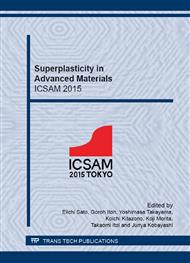p.574
p.581
p.586
p.592
p.597
p.603
p.610
p.615
p.621
Promises of Low-Temperature Superplasticity for the Enhanced Production of Hollow Titanium Components
Abstract:
Application of the conventional superplasticity (SP) allows producing the unique hollow structures. One remarkable example is the hollow titanium blade of the air engine fan produced by Rolls-Royce. However, high temperature titanium alloys processing (~ 927 °С) limits wide industrial application of the conventional SP. The solution of the mentioned issue can be found through the application of low-temperature SP. Ti-6Al-4V alloy with ultrafine grain structure at the temperature range of 600 800 °С has enough ductility resources for the superplastic forming (SPF) of the parts with the complicated shape. The formation of pores in Ti-6Al-4V alloy at uniaxial and biaxial tension at the temperature 600 °С is not observed. The effect of low-temperature SP also allows lowering pressure welding (PW) temperature essentially. Herewith, there is a possibility to produce the hollow parts by the combination of SPF and PW. The main goal is the optimization of the technological scheme and processing temperature. The use of the low-temperature SP provides high quality of hollow components such as blades.
Info:
Periodical:
Pages:
610-614
Citation:
Online since:
January 2016
Price:
Сopyright:
© 2016 Trans Tech Publications Ltd. All Rights Reserved
Share:
Citation:


